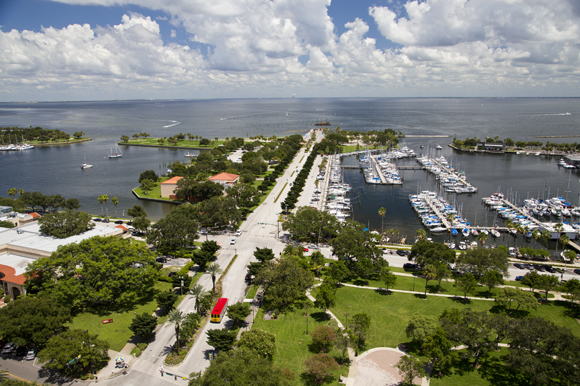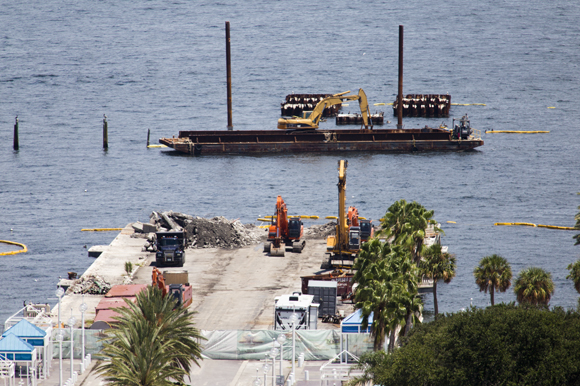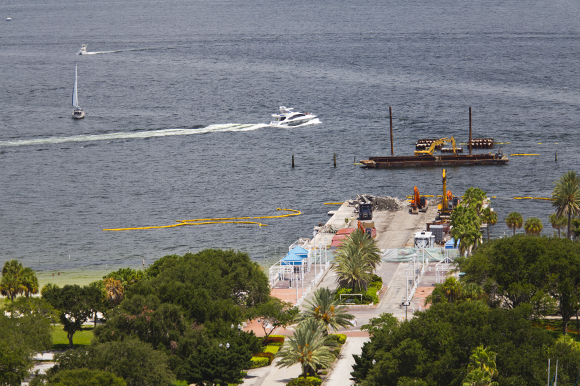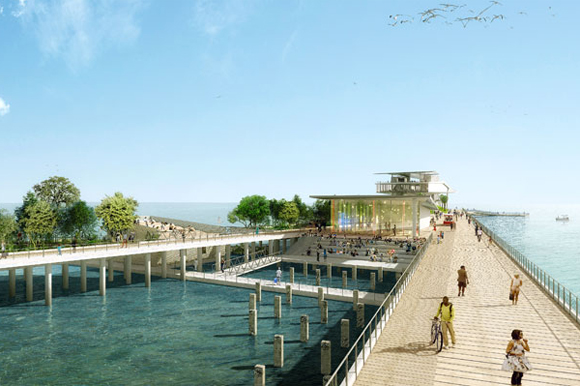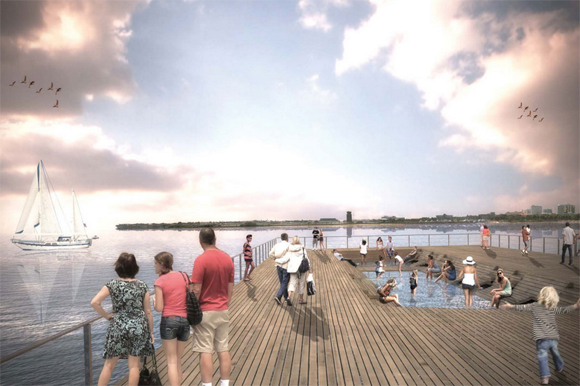What will the new St. Pete Pier look like?
Designers, architects and St. Petersburg officials are engaging locals and tourists in a new pier design intended to proudly represent the city and enhance the popular Bayfront area for decades to come.
The last scraps of St. Petersburg’s famous old inverted Pier, which served as an iconic tourist attraction and photogenic landmark from 1973 through 2013, will be gone by the end of September.
“Demolition will be complete,” says Kristin Brett, the communications specialist for the City of St. Petersburg. Demolition contractor Sonny Glasbrenner is wrapping up removal of the pier approach, which dates back to 1926.
Concrete and other materials from the old structure and the 90-year-old approach are being cleaned and repurposed for other projects, including shoreline protection rip rap at nearby Albert Whitted Airport.
Detailed Pier plans emerge
As the last traces of the old pier vanish from the bay, officials have been spending time this summer huddled around drawing boards and at council meetings preparing for construction of the new St. Pete Pier.
“There’s a lot happening … with the pier behind the scenes,” Brett says. At an August 4 meeting, St. Petersburg City Council approved $19.5 million for construction of the pier approach, which will lead guests to the main pier head structure some 1,100 feet into the bay.
“The pier team is working on construction documents and are moving from conceptual design to schematic design. Permitting is also moving along well,” Brett says. Permitting agents include the Army Corps of Engineers and Southwest Florida Management District, among others.
While permits gain approval, individuals such as Barbara Wilks, lead designer for the pier approach and founder and principal of W Architecture & Landscape Architecture, are moving the planning process forward.
“Schematic design is expected to start in September,” Wilks says.
Approach plans call for a central pedestrian corridor, flexible market square, a Key West-style restaurant, a children’s play area, a versatile event area and parking.
“Balancing the needs and desires of community members is one challenge that faces any project with public use. Our concept brings together as much of the community’s wants and needs for this space as possible while working under a defined budget.”
Open house meetings in September
Chris Ballestra, Managing Director of Development for the City of St. Petersburg, says integrating the needs and wants of the public into a project that also makes a bold statement is the primary objective of the new St. Pete Pier.
“The project has been publicly driven and concept driven — a project where things continue to get better every day,” he states.
Ballestra and the new St. Pete Pier team will be holding three open house sessions throughout the city of St. Petersburg in mid-September that will give the public a chance to learn about the pier, meet with architects and city officials, and provide input in roundtable discussions. (Details on the open house meetings for the new St. Pete Pier can be found at the conclusion of this article.)
In addition, Ballestra has been exchanging ideas in New York with approach planner W Architecture and pier designer Rogers Partners Architects + Urban Designers (both firms are based in New York City). Ballestra says the collaborative process between the various players is going smoothly.
“The goal is to dovetail the two different parts of the design elements, the approach and over-water feature, into a single project that looks seamless,’’ Ballestra says.
The next step is creating the construction documents that will serve as the roadmap for contractors as they put the pieces together for the new pier and approach, which could be under construction as early as January or February 2017.
“We plan to finish the project in fall 2018,” he says.
What the new St. Pete Pier will offer
The new pier includes a multi-level shopping, dining and entertainment venue at the end of the approach.
“The [new] building will be the same height as the inverted pyramid pier, or about 52 feet,” Ballestra explains. “However, while the inverted pyramid had five stories including the rooftop deck, the new pier will have just three enclosed stories, so each floor will have more ceiling height than the previous pier did.”
While there are many elements that will be incorporated into the new St. Pete Pier project, including more activities and attractions along the pier approach and new venues in the main pier building, there are at least two characteristics about the old pier that respond directly to consensus reached through earlier public input.
“Number one, they wanted to retain the unique observational views, and two, they wanted a restaurant and dining options,” he explains. The inverted pyramid structure contained two destination restaurants, Cha Cha Coconuts and The Columbia Restaurant, as well as several small cafes and snack bars.
“While the old pier required you to walk out to the end to enjoy the dining and shopping clustered around the pyramid, the new pier will have more things to do along the entire stretch, such as the kids play zone.”
The new pier will also be significantly closer to the shore than the inverted pyramid was by “about 130 to 140 feet,” according to Ballestra. Meanwhile, the four caissons, or foundational structures, which supported the inverted pyramid pier for more than 40 years, are being put back into use for the new St. Pete Pier.
“The four caissons and a fifth caisson that supported the main elevator shaft are being reused for a very large fishing platform that will sit just east of the new pier building,” says Ballestra. “The old caissons were cut off at the water level.”
Reminiscing while looking to the future
For Ballestra, a longtime City of St. Petersburg official, the new St. Pete Pier carries a special meaning.
“It’s a legacy project,” he says. “It will be the pier my kids use, and the one their kids can use, too. We’re building it with a 75-year design, yet it’s a flexible building that can change as tastes change down the road.”
Changing tastes have influenced the design of St. Pete Pier projects since 1889, when the city’s first pier was built. The wooden structure supported a spur of the Orange Belt Railway and was known as the “Railroad Pier.” The Electric Pier that came in 1906 was 3,000 feet long and in 1914 was paralleled by the Municipal Pier, which stood just 10 feet away. After a massive hurricane destroyed both piers in 1921, the Mediterranean Revival-styled Million Dollar Pier was constructed on the same site as Municipal Pier.
The Million Dollar Pier opened in 1926 and was a major draw for more than 40 years, until its demolition in 1967. Construction subsequently took place on the inverted pyramid pier structure throughout 1970 and 1971.
St. Petersburg architect William B. Harvard, Sr., designed the inverted pyramid building, which looked every bit as unique as Harvard’s other Tampa Bay area modern-style tourist landmark: the former Hospitality House (now Garden Gate Café) at Busch Gardens Tampa, which opened with the park in 1959 and includes a seven-sided “floating” roof.
The inverted pyramid pier opened on Jan. 20, 1973 and was extensively renovated in 1988, when the addition of shops and cafes in a cluster of new buildings on the first floor attempted to remedy revenue shortfalls and lagging guest attendance. While locals and tourists came, guest numbers were virtually never enough to financially sustain upkeep on the aging structure.
Calls to replace the inverted pyramid pier came as early as 2004, and in 2009 the Pier Task Force researched the logistics and possibilities of replacing the pier. Some organizations, such as Save The Pier, opposed the demolition of the inverted pyramid. Still, plans for the new St. Pete Pier carried on, and an international design competition yielded several creative entries for a new design.
With a final pier design now set and schematic documents about to be filed with the city, locals and tourists can look forward to soon getting a pier back in St. Petersburg. “It will be a destination attraction that people from all over the world can enjoy.”
Public is invited to New St. Pete Pier Open House meetings
Three open house meetings will occur in St. Petersburg on September 13, 14 and 20. All are invited, including those who live outside the City of St. Petersburg, and attendees are encouraged to voice their ideas.
September 13, 2016, 6-7:30 p.m.
Roberts Park Recreation Center
1246 50th Avenue North
St. Petersburg, FL 33703 727-893-7754
September 14, 2016, 6-7:30 p.m.
J.W. Cate Recreation Center
5801 22nd Avenue North
St. Petersburg, FL 33710
727-893-7751
September 20, 2016, 6-7:30 p.m.
Lake Vista Recreation Center
1401 62nd Avenue South
St. Petersburg, FL 33705
727-893-7744

